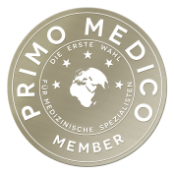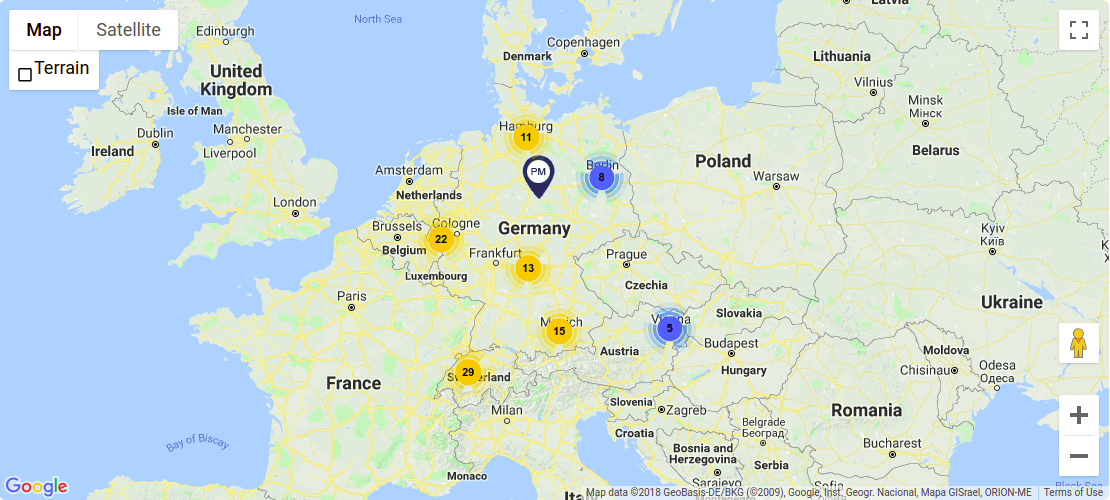Vascular Specialist Dr Ludwig – Head Physician Vascular Surgery Dresden
Treatment focus
- Aneurysms of the thoracic and abdominal aorta (conventional open surgery and minimally invasive endovascular stent-graft implantation)
- Perfusion disorders of the brain supplying arteries (carotid artery stenosis)
- Arterial circulatory disorders (pelvic and leg vessels, neck and arm vessels, visceral and renal arteries)
- New placement and revisions of dialysis shunts
- Varicose vein disease
Contact
Municipal Hospital Dresden-Friedrichstadt
Department of Vascular Surgery, Vascular and Endovascular Surgery, Phlebology
Friedrichstraße 41, D-01067 Dresden
P: +49 351 8380 9054 F: +49 351 480 1109
Consultation Hours:
Mon-Fri
from 12 PM to 3 PM or by appointment

Medical Range
Range of Diagnostic Services
All examination procedures relevant to vascular medicine are available at the Städtisches Klinikum Dresden. Special consultations provide targeted and focused diagnostics and therapy planning (aorta, PAD, veins, and shunt).
- CT angiography
- MR angiography
- Conventional angiography
- PET-CT angiography
- Ankle artery occlusion pressure measurement (arm-leg index, toe-arm index)
- Treadmill examinations
- Acral light plethysmography (ALP) Color-coded duplex sonography (with contrast agent too)
Range of Therapeutic Services
- Aorta
thoracic and abdominal aortic aneurysms (asymptomatic, symptomatic, ruptured), acute aortic syndrome dissections, penetrating aortic ulcer (PAU), intramural hematoma (IMH) with EVAR, TEVAR, implantation of complex aortic stent prostheses (branched, fenestrated) - Carotid and Vascular Head/Neck Surgery
Surgery for correcting stenosis or dilatation under general and regional anesthesia with neuromonitoring or shunt, bypass devices (autologous vein replacement material, vascular prosthesis), intraoperative stents - Circulatory Disorders of the Legs (Peripheral Arterial Occlusive Disease and Diabetic Foot Syndrome)
Hybrid surgeries from the groin with endovascular treatment of further constrictions, bypasses (autologous vein material, vascular prosthesis) - Dialysis Access Surgery
New placement of arteriovenous fistulas, corrective surgeries in hybrid technique, prosthetic shunt placement, HERO graft, tunneled catheter placement - Circulatory Disturbance of Visceral and Renal arteries
Removal of narrowing and reconstruction by dilatation patch, bypass, stent implantation - Venous and Varicose Vein (varicose) Disease
Removal of clots, varicose vein treatment (surgical and endovenous), complex therapy of late-stage chronic venous insufficiency (decongestion, vascular treatment, fascia splitting/resection, wound treatment)
More Information
Card
Dr Stefan Ludwig is a specialist in vascular surgery and head physician of the Department of Vascular Surgery, Vascular and Endovascular Surgery, and Phlebology at the Municipal Hospital Dresden.
The Department of Vascular Surgery provides the full range of modern vascular medicine, including all conventional and minimally invasive surgical procedures, for diagnosing and treating arterial and venous diseases. The department is part of the interdisciplinary Vascular Center certified by the German Society for Vascular Surgery.
Dr Ludwig's experienced and dedicated medical team assesses whether purely medical therapy, a catheter procedure, or surgical intervention is necessary for the patient and determines an individual treatment strategy accordingly.
Initially, there is always an evidence-based and guideline-oriented indication for surgery/intervention. Then, to consider all facets, a treatment recommendation is always made after discussing the available findings in the interdisciplinary vascular conference by vascular surgeons, angiologists, radiologists, and, if necessary, other specialist disciplines.
The Interdisciplinary Vascular Center has been continuously certified by the three professional societies since 1996.
As far as possible, surgeries are carried out in the hybrid surgery room, which allows a combination of open surgery and endovascular - minimally invasive - procedures by using high-quality technology for X-ray, vascular imaging, and, if necessary, intraoperative tomography.
Specialist for Aneurysms of the Thoracic and Abdominal Aorta
Aneurysms are defined in medical terminology as the bulging of a section of a vessel as a result of weakness in the connective tissue in the wall layers of the affected vessel. In principle, these can occur in all arterial vessels of the organism. Since such predetermined rupture points can burst when the wall tension of the vessel is high, aneurysms usually carry a high-risk potential. High wall stresses occur due to blood pressure peaks, increased pressure in the abdominal and thoracic cavities, or severe shocks. If the vessel ruptures, life-threatening and difficult-to-control internal bleeding occurs. Due to their wide diameter and high blood flow in the aorta, aortic aneurysms are ticking time bombs that should be surgically relieved promptly upon diagnosis.
Comprehensive Diagnosis and Treatment of Circulatory Disturbances of the Brain-Supplying Arteries
Circulatory disorders of the brain-supplying arteries are particularly critical. These paired vessels enter the skull at the front as the common carotid artery through the cervical fascia and at the back as the vertebral artery through a bony canal in the spinal column.
If stenoses (constrictions) occur in its course, such as atherosclerotic calcifications, an adequate blood supply to all brain areas can no longer be ensured. Classic symptoms of such stenosis are dizziness, ringing in the ears, or even fainting episodes. During a catheter intervention, such constrictions can be widened using small balloons, and a so-called stent (vascular support) can be used to prevent the constriction from closing again.
A High Level of Expertise in the Field of Arterial Circulatory Disorders (Pelvic and Leg Vessels, Neck and Arm Vessels, Internal Arteries)
In the case of vascular stenosis, the supply area of the affected pathway is insufficiently supplied with oxygen and nutrients. As a result, carbon dioxide and other metabolic waste products accumulate in the area with insufficient blood supply. Depending on the vessel affected, a wide variety of symptoms become noticeable. In particular, oxygen-dependent tissues such as the brain, heart muscle, or working skeletal muscles quickly fail to function when there is a lack of oxygen.
A common disease in industrialized countries is a peripheral arterial occlusive disease, also known as window-shopping disease. This popular name comes from the fact that those affected can only walk short distances, i.e., from one shop window to the next, without pain, before giving the undersupplied muscles a break.
The causing vascular occlusions of the pelvic and leg arteries can also be dilated in a catheter intervention using balloon dilatation and kept open by stent implantation. In severe cases, the vessel must be surgically exposed and opened to remove the plaque with an adherent blood clot (thromboendarterectomy). In the case of the highest degree of occlusion, the occlusion can be bridged by a surgically created vascular bypass.
State-of-the-Art Diagnostics & Therapy for Carotid Artery Stenosis
Thanks to Doppler sonography and computer tomographic imaging, carotid stenosis can be reliably diagnosed today. Doppler or duplex sonography is a non-invasive procedure based on ultrasound technology that allows precise blood flow calculation in the carotid arteries. Subsequently, for optimal therapy planning, the three-dimensional extent of the constriction can be visualized by computer tomography, if necessary, with a contrast agent.
While the progression of the disease can be prevented by early diagnosis through avoidance of all risk factors, such as tobacco consumption and lack of exercise, and medication to control high blood pressure, blood sugar, and blood lipid levels, dilatation and stent implantation using a catheter procedure can be considered for medium grade stenoses. However, the plaque must be peeled out for high-grade stenosis in an open surgical procedure.
Varicose Vein Treatment at the Municipal Hospital Dresden
Varicose veins occur predominantly in the lower extremities. They express a predisposed weakness of the vein wall, which can be further aggravated by permanent congestion of the bloodstream in the legs, for example, due to long periods of standing at work. As a result, the blood no longer flows appropriately towards the heart but instead accumulates in the veins, e.g., in the calf, where it leads to unsightly bulges. In addition, the slowed blood flow favors the development of venous thrombosis. If conservative measures, such as wearing compression stockings, do not show any significant improvement, the varices can be sclerosed by injecting a saline solution. However, this is likely to damage the inner layer of the vessel wall, causing the vessel to contract and be displaced by a blood clot before being transformed into a bloodless connective tissue strand. If this attempt of sclerotherapy is unsuccessful, the surgical extraction of the varicose vein via two small skin incisions remains a therapy option (varicose vein stripping).
Placement of Shunts (Dialysis Shunt Surgery)
If permanent dialysis therapy is required to treat chronic renal insufficiency, the patient can be relieved of suffering if extensive vascular access can be created without any problems. This is made possible by a so-called dialysis shunt, a short-circuit connection of arteries and veins, usually in the forearm. This large-lumen vessel can be pierced with a needle as painlessly as possible, usually in the first attempt, and dialysis treatment can be administered through it. Dr Ludwig and his team have already created numerous dialysis shunts, making the complex treatment easier for many dialysis patients.
For more information, please visit the website of the Department for Vascular Surgery.
Curriculum Vitae
| Since 1 October 2022 | Head Physician of the Clinic for Vascular Surgery at the Städtisches Klinikum Dresden |
| November 2006 – September 2022 | University Hospital Carl Gustav Carus at the TU Dresden, Department for Visceral, Thoracic and Vascular Surgery (Prof. Dr. med. J. Weitz; em. Prof. Dr. med. H. D. Saeger) |
| Since 07/2015 | Senior Physician, Representative Head of Division Vascular and Endovascular Surgery, (Head: Prof. C. Reeps), Department of Visceral, Thoracic and Vascular Surgery, Carl Gustav Carus University Hospital, Dresden, Germany |
| 02/2013 – 06/2015 | Acting Senior Physician, Department of Visceral, Thoracic and Vascular Surgery, Carl Gustav Carus University Hospital, Dresden, Germany |
| 2012 | Specialist for Vascular Surgery |
| Since 12/2009 | Specialist for Surgery at the University Vascular Center Dresden |
| 01/2009 – 12/2009 | Specialist for Surgery at the University Cancer Center Dresden (Comprehensive Cancer Center) |
| 2008 | Specialist for Surgery |
| 11/2006 – 12/2008 | Assistant Physician/Specialist in Surgery/Scientific Staff Member |
| 01/2006 – 10/2006 | University Hospital Leipzig, 2nd Surgical Department (Prof. Dr. med. J. Hauss), Assistant Surgeon/Scientific Staff Member |
| 2005 | Doctorate in Medicine Distinction: Magna Cum Laude |
| 10/2003 – 12/2005 | University of Wisconsin in Madison, Dept. of Surgery, Division of Transplantation, USA (Head: Prof. Dr. Dr. h.c. H.W. Sollinger) Research Fellow (Scholarship of the Roland-Ernst-Foundation for Health Care) (Main-Focus: Hepatocyte-Based Insulin Gene Therapy for Type 1 Diabetes Mellitus Second-Focus: Evaluation of a Modified MMF Formulation in Canine Kidney Transplantation) |
| 04/2003 – 09/2003 | Surgical Intensive Care Unit |
| 11/2002 – 03/2003 | Central Emergency Room |
| 05/2002 – 10/2002 | General / Trauma Surgery, "Hufeland-Klinikum," Bad Langensalza, (Resident Exchange Program) |
| 12/2001 – 05/2002 | Vascular Surgery |
| 2001 | Full Licence to Practice Medicine |
| 07/2000 – 09/2003 | University Hospital Leipzig, Surgical Clinic II - Visceral, Transplantation, Thoracic and Vascular Surgery (Director: Prof. Dr. med. J. Hauss), Internship Physician, Surgical Assistant |
| 06/2000 – 11/2001 | Surgical Research |
| 2000 | Partial Licence to Practice Medicine |
| 1993 – 2000 | Study of Human Medicine, Medical Faculty of the Technical University of Dresden |
Prizes/Awards, Scholarships
| 2012 | Lecture Award of the German Society for General and Visceral Surgery |
| 2004 – 2005 | Scholarship of the Roland-Ernst-Foundation for Health Care |
Advanced Training and Continuing Education
| 2019/2020 | Modular Management Training |
| 2019 | Courses for Obtaining the Title "Endovascular Surgeon" and "Endovascular Specialist." |
| 2018 | DIPOL® - Medical Didactics Workshop |
| 2017 | Technical Qualification in Radiation Protection (X-ray Diagnostics of the Vascular System, Application of X-rays in Interventions on the Vascular System, Except for the Heart) |
| 2013 | Principal Investigator Course |
| 2012 | Special Course Interventional Radiology |
| 2009 | Primary and Special Course in Radiation Protection for Physicians During Examinations with X-rays |
Team
- Dr Carsten Rilke
Senior Physician in Charge - Mr. Victor Lapikov
Specialist for Vascular Surgery and Surgery - Mrs. Maria Kuntzsch
Specialist for Vascular Surgery - Mr. Alan Gilberto Gonzales Garca
Physician in Advanced Training Vascular Surgery - Mr. Georges Khoueiry
Physician in Advanced Training Vascular Surgery - Mrs. Pia Mann
Specialist for Visceral Surgery, Physician in Advanced Training in Vascular Surgery
Transport Connections
| Dresden Main Station | 4 km |
| Dresden Airport | 12 km |
Information about Dresden
Dresden inspires as a real work of art and offers fascinating buildings, art treasures, an impressive museum landscape, and sound institutions that enjoy world fame. Discover the city and its beautiful surroundings. Dresden not only has a historic old town worth seeing but is also a young and modern metropolis with many facets.











